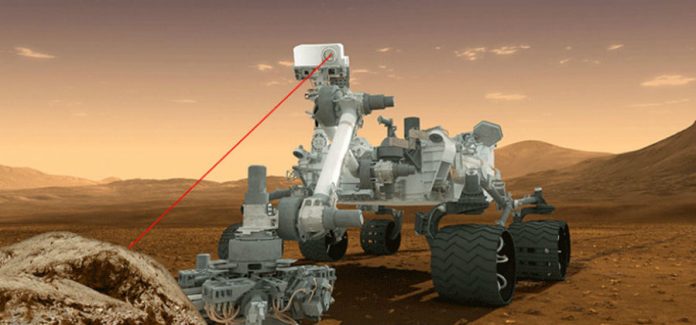
NASA’s Curiosity rover can now shoot lasers at rocks on Mars without the help of humans. The rover, according to the criteria established by scientists, identifies foundations based on its size and brightness, and then proceeds to shoot them to reveal their composition.
Equipped with Sample Analysis at Mars (SAM), the Curiosity rover is capable of searching for organic compounds on the Martian surface. The discoveries will be used further to investigate the geological layers on Mount Sharp.
Pre-production
Curiosity is a car-sized robotic rover exploring Gale Crater on Mars as part of NASA’s Mars Exploration Program. To date, it has spent 1446 days in the Red Planet’s hostile conditions.
The rover was landed by the Mars Science Laboratory (MSL) and the Curiosity Project Team on August 6, 2012. Later that same year, Curiosity’s two-year mission was extended indefinitely.
NASA’s Jet Propulsion Laboratory (JPL), the center where the rover was manufactured, was awarded the 2012 Robert J. Collier Trophy by the National Aeronautic Association.
JPL’s award was “in recognition of the extraordinary achievements of successfully landing Curiosity on Mars, advancing the nation’s technological and engineering capabilities, and significantly improving humanity’s understanding of ancient Martian habitable environments.”
Curiosity was designed and built by Rocketdyne and Teledyne Energy Systems, and will serve as the base for planned successor Mars 2020 rover.
Dynamite with a Laser Beam: I can now choose rocks to zap with ChemCam on my own. #pewpew https://t.co/LykbkDIJmM pic.twitter.com/lBifknxhdZ
— ARCHIVED – Curiosity Rover (@MarsCuriosity) July 21, 2016
Inquisitive Curiosity
Curiosity is powered by a radioisotope thermoelectric generator (RTG), like the successful Viking 1 and Viking 2 Mars landers in 1976. In fact, the Mars rover owes its existence to the Viking technology, but unlike its predecessors, information gathered by Curiosity is uploaded to the Planetary Data System online for the scientists to access it quickly.
As established by the Mars Exploration Program, the curious rover’s primary goals are to investigate the Martian climate and geology. Curiosity’s goal is to determine the role of water in the Red Planet and verify if Mars has ever offered environmental conditions favorable for any form of life, including microbial life. To conduct planetary habitability studies to help prepare for human exploration is also in the to-do’s list for Curiosity.
https://www.youtube.com/watch?v=jpx49XuNjyQ
One year into the mission, Curiosity’s explorations determined that, in the past, Mars was indeed a hospitable planet for microbial life. In consequence, the MSL added to the mission the task to preserve organic compounds and biomolecules found on the Martian surface.
Behind the scenes
Having landed on the Red Planet in 2012, this was the first time that Curiosity, and for that matter, any other instrument, has operated autonomously, according to NASA. The ‘autopilot’ upgrade was possible thanks to a software called AEGIS (Autonomous Exploration for Gathering Increased Science) developed at NASA’s JPL.
AEGIS allows the rover to use its laser and the Curiosity Chemistry and Camera (ChemCam) instrument, with the purpose of identifying targets following the directions of what scientists on Earth are looking for.
Superstar! Saluting @NASA's first Mars lander with #Viking40 live talks July 19-20 on https://t.co/CoE5S8rX06 pic.twitter.com/PHqw9vJMtT
— ARCHIVED – Curiosity Rover (@MarsCuriosity) July 19, 2016
The sequel
Mars 2020 is the title of NASA’s next mission to Earth’s twin planet, in which the new rover will investigate the region of Mars that was formerly hosted microbial life.
The Curiosity rover is expected to land on the Red Planet in 2021 to begin looking for evidence that points to the existence of life in the past.It will also collect samples of soil and rock, which will be brought back to Earth by another mission still to be determined.
Source: Tech Times










